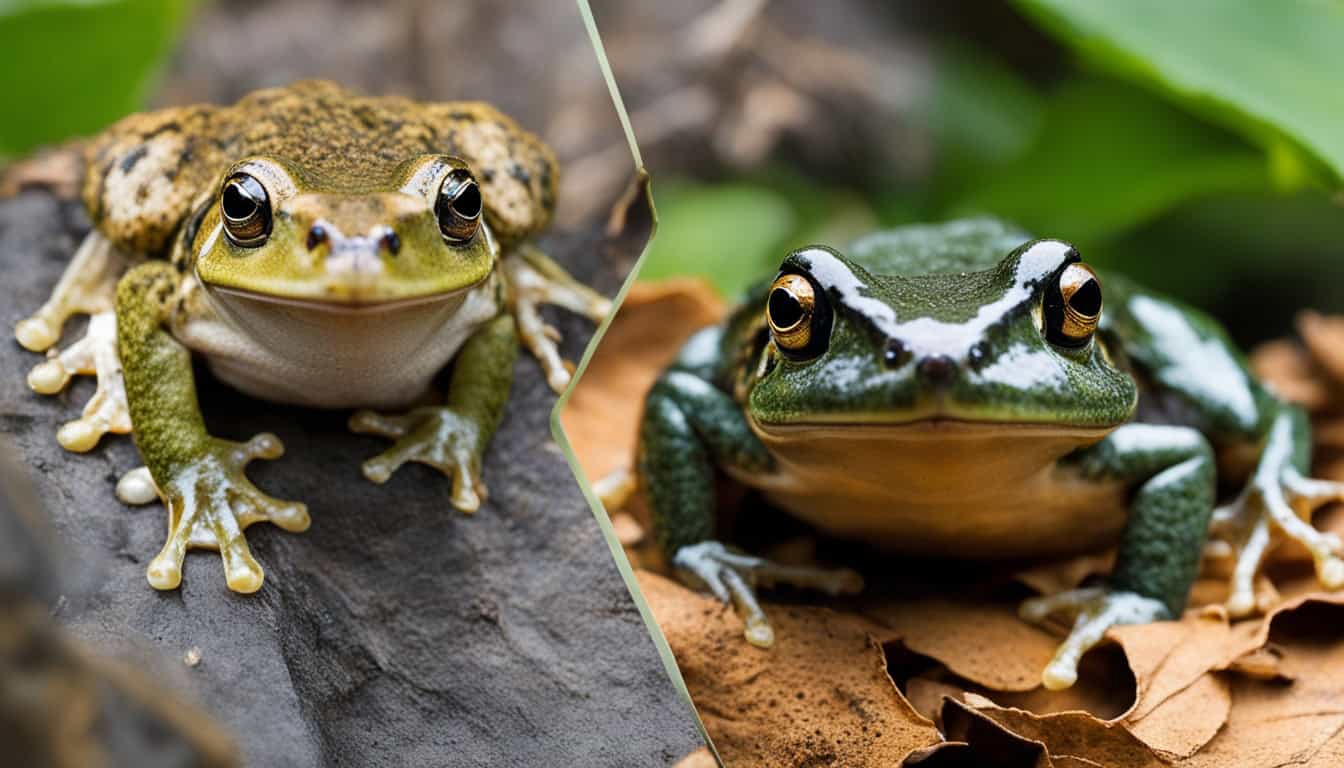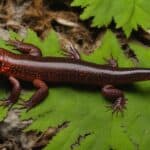It can be hard to tell the difference between frogs and toads. They look a lot alike but have some unique traits. They are both amphibians without a tail and fall under the Anura order. This group includes true frogs (Ranidae) and true toads (Bufonidae), among others.
Frogs have skin that’s moist and smooth. They are known for their ability to jump far with their long, powerful back legs. Toads, on the other hand, have dry, rough skin. They are better at walking than jumping, given their shorter legs. Frogs mainly live closer to water, while toads can stay in dry places better. These differences are important for telling them apart.
Even with their similarities, frogs and toads adapt uniquely to their surroundings. This makes figuring out the differences between them both fun and interesting.
The Scientific Classification of Frogs and Toads
Understanding frog and toad scientific classification is key. They both fall under the Anura order, a wide group with many families. The two main families are Ranidae, which includes true frogs, and Bufonidae, housing true toads.
The term “toad” is part of the bigger group called “frog.” However, differentiating is tricky because no clear scientific distinction exists between the two. This can cause confusion when dealing with identifying frogs and toads, mainly because they share many traits.
Where they live plays a big role in classification within the Anura order. For example, tree frogs belong to a different family than true frogs. This adds to the complexity when trying to tell frog and toad characteristics apart. It shows the importance of considering where species live in their classification.
| Family | Common Name | Characteristics |
|---|---|---|
| Ranidae | True Frogs | Usually found near water; smooth and moist skin |
| Bufonidae | True Toads | Tolerate drier environments; dry, bumpy skin |
| Hylidae | Tree Frogs | Adapted to arboreal habitats; equipped with adhesive pads |
| Microhylidae | Narrow-mouthed Frogs | Small and often terrestrial or fossorial |
Skin Texture: A Key Identifying Feature
It’s key to know the skin texture for frog or toad identification. Their skin fits their environments, making them different. Let’s look at their skin to improve frog and toad comparison skills.
Smooth and Moist Skin
Frogs stand out with smooth, moist skin. They live by water and the moisture in their skin helps them breathe and stay wet. This link to water is vital for their life and their skin’s special feel.
Dry, Bumpy Skin
Toads, however, have dry, bumpy skin. This roughness helps them live on land. Toads don’t need to stay near water like frogs do. This difference is useful for telling frogs or toads apart and boosting your frog and toad comparison knowledge.
Understanding Habitat for Identification
Knowing where frogs and toads live is key to telling them apart. By looking at the areas they live in, we can understand the differences between them. This is a big step in figuring out what kind of amphibian you’re seeing.
Proximity to Water
Frogs enjoy places near water. You’ll see them by ponds, lakes, streams, and other wet spots. They need to keep their skin wet, so you’ll often find them in or by water.
Their smooth skin shows they love being close to water.
Further from Water
Toads are comfortable away from water. They live in dry places like gardens, forests, and fields. Their rough, dry skin helps them keep from drying out. When you see an amphibian in a dry area, it’s probably a toad.
Physical Differences: Legs and Movement
Frogs and toads are different in how they look and move, especially their legs. Frogs jump with their long, strong hind legs. This makes them good at escaping danger and swimming fast. They really stand out because of how far and high they can jump.
Long, Strong Hind Legs
Frogs have long and powerful hind legs. These let them jump far and swim easily. Jumping helps them stay safe from enemies. It also helps them find food. This is a big difference between frogs and toads, and it shows in how they move.
Short, Stocky Legs
Toads, however, have short, stout legs. They’re not great at jumping but can do short hops. These differences in how toads and frogs move show their unique ways of staying safe and finding food.
Frogs’ jumping is great for survival, while toads’ calmness and camouflage keep them safe. The way they use their legs is all part of how they’re built for their worlds.
The Role of Eyes in Identification
Frogs and toads have distinct eyes. They help us tell the difference between the two. You can see if it’s a frog or a toad by their eye size and position. Let’s delve into their eye disparities.
Big, Bulging Eyes
Frogs usually sport big, bulging eyes. These eyes are great for seeing in many directions. They are very useful when frogs are in or around water. This is because they help frogs watch out for danger and find food easily.
Subtle Eyes
Toads, on the other hand, have smaller, less noticeable eyes. This is perfect for their life on land. Their tiny eyes tell us they aren’t as focused on hunting. So, seeing toads’ subtle eye details is key to identifying them.
| Feature | Frogs | Toads |
|---|---|---|
| Eye Size | Big, bulging | Small, subtle |
| Visibility | Highly visible | Less noticeable |
| Primary Habitat | Aquatic | Terrestrial |
Behavioral Responses to Threats
Frogs and toads show interesting differences in how they react to danger. It’s fascinating to watch this phenomenon. They use specific methods to stay safe from harm, based on where they live and what they look like.
Leaping Away
Frogs escape danger by jumping with their strong legs. They aim for water, using their fast moves. This is not only a move to get away quickly. Water is safe for them because their skin helps them swim well.
Staying Still
Toads, however, don’t move much when they’re in trouble. They’re masters at staying hidden. Their skin looks like their environment, mixing them in, which confuses predators. So, being motionless is their smart way of keeping safe since they can’t jump like frogs can.
Toxicity: Toads are More Poisonous
Toads and frogs differ a lot when it comes to how toxic they are. Toads have special glands that make them poisonous. These *parotoid glands* release strong toxins to protect them from danger.
Touching a toad’s skin can be dangerous because of these toxins. In contrast, frogs are usually not toxic. This shows that they have different ways of staying safe.
| Feature | Frogs | Toads |
|---|---|---|
| Toxicity | Generally non-toxic | Poisonous due to toad poison glands |
| Defense Mechanism | Evading predators by leaping | Produce toxins from skin |
Toads use their toxins to keep enemies away, but frogs just hop away. It’s important to know these differences, especially if you meet them in nature.
Eggs: Frog Cluster vs Toad Chain
How frogs and toads lay their eggs helps us tell them apart. Frog eggs come in big clusters. These clusters can often be found floating on water or stuck to plants.

Toad eggs, however, are laid out in long chains. These chains wind around plants in the water. It’s important to know this for telling frog and toad eggs apart.
| Egg Arrangement | Description | Example |
|---|---|---|
| Frog Cluster | Eggs are laid in masses or clusters, often floating or attached to vegetation. | Commonly seen in ponds and wetlands. |
| Toad Chain | Eggs are laid in linear chains, usually wrapped around aquatic foliage. | Often found in shallow water bodies. |
These egg types are special and show how each breed has evolved. Knowing this helps identify frog and toad eggs, especially during breeding times.
Identifying Frog and Toad Tadpoles
Frog and toad tadpole differences are key in understanding their growth. This knowledge helps in finding and recognizing them in the wild.
Frog tadpoles are usually thin and shine with gold spots. This shows they can live in many water types.
Toad tadpoles are different, being thick and nearly all black. This shows how they’re suited to certain places. Their looks tell a lot about where they live, which is important in telling frogs and toads apart.
| Feature | Frog Tadpoles | Toad Tadpoles |
|---|---|---|
| Body Shape | Slender | Chunky |
| Color | Gold Flecks | Plain Black |
Knowing these frog and toad tadpole differences can help you enjoy and respect amphibians more. The next time you see tadpoles, you’ll have some keys to tell frogs and toads apart.
Environmental Indicators: Health of Ecosystems
Frogs and toads are key to understanding how healthy our environment is. They tell us a lot about the places they live in. Seeing them shows if an area is doing well or not.
These creatures are very sensitive. They can quickly pick up on changes and pollution. This is because their skin can absorb things around them. So, when their numbers change, it often means something is happening to their home.
Now, let’s see how frogs and toads help us understand the health of our environment:
| Aspect | Frogs | Toads |
|---|---|---|
| Habitat Sensitivity | Highly sensitive to moisture and water quality | Moderately sensitive, can tolerate drier conditions |
| Pollution Indicators | Quickly affected by chemical pollutants | Display slower response to pollutants |
| Population Changes | Decline rapidly in degraded environments | May persist longer in moderate environmental stress |
So, frogs and toads are super important for us to understand our ecosystems. By watching them, we learn a lot about the health of the places they live in. This knowledge is key for protecting and restoring nature.
Understanding Regional Distribution
The frog and toad regional distribution tells us a lot about their lives and places they live. Frogs live in many different places, from hot rainforests to dry deserts. They’re on every continent except Antarctica. This shows frogs can live in many different places thanks to their unique abilities.
Toads, on the other hand, have specific places they like. They live in many areas but not in places like the North and South Poles, Australia, Polynesia, and Madagascar. This tell us they choose places that suit their needs. Knowing where frogs and toads live helps us look into their past and protect their homes today.
| Region | Frogs | Toads |
|---|---|---|
| Antarctica | No | No |
| Australia | Yes | No |
| Polynesia | Yes | No |
| Madagascar | Yes | No |
| Polar Regions | No | No |
| Other Continents | Yes | Yes |
Final Thoughts on Amphibian Identification
Understanding frogs and toads needs detailed knowledge. They are both under the Anura group but have unique and shared traits. This includes skin feel, where they live, how they look, act, and reproduce. Knowing these differences is key for spotting the right one. It also helps us see how important they are in nature.
Frogs are known for their smooth, wet skin. On the other hand, toads have dry, rough skin. Their living spaces differ too, with frogs near water and toads living in drier spots. Looking at their legs is another way to tell them apart. Frogs have long back legs for big jumps. Toads have shorter legs better for walking. These differences are also why they act differently when scared. Frogs leap away quickly, but toads may stay still to hide.
Different ways they reproduce can also help with IDs. Frogs lay eggs in clumps, but toads line theirs up like beads. When the eggs hatch, looking at the young can be another clue. Another key point is how toxic some toads are. Their ability to make poison is a strong defense. By using a guide on identifying these animals, you can get better at it. This deepens your knowledge of them and what they do for the environment.
FAQ
How do you distinguish between a frog and a toad?
Frogs have smooth, wet skin and can leap far with their strong legs. In contrast, toads have dry, lumpy skin. They move by short hops or crawling. Toads do well in dry places, but frogs like to live near water.
What is the scientific classification of frogs and toads?
Frogs and toads fall under the order Anura. For example, Ranidae includes true frogs, and Bufonidae has true toads. While toads are a type of frog, not all frogs are toads. This shows a more detailed relationship between them.
How does skin texture help in identifying frogs and toads?
Frog skin feels moist and smooth. This adapts them for living in wet places. In contrast, toads have dry, rough skin. It helps them survive in dry lands, away from water.
What are the habitat preferences of frogs and toads?
Frogs are often found near water because they need to keep their skin moist. Toads can live farther from water due to their skin’s ability to keep some moisture locked in.
How do the legs and movement of frogs and toads differ?
Frogs have long legs for jumping. This helps them escape quickly. Toads have shorter legs. They make small hops or crawl instead of jumping long distances.
What role do eyes play in identifying frogs and toads?
Frogs have big, round eyes. These are good for seeing in the water. Toads have small eyes that suit their life on land better. This is part of what makes them different.
How do frogs and toads behave when threatened?
When in danger, frogs leap into water using their strong legs to get away. Toads, however, stay still. They count on their looks and sturdy body to blend in or protect themselves.
Are toads more poisonous than frogs?
Yes, toads are poisonous. They have glands that release toxins as a defense. These toxins can harm you. Frogs usually don’t have this trait.
How can you differentiate between frog and toad eggs?
Frog eggs are in clusters that float on water or stick to plants. Toad eggs are in chains that wind around plants. This is a key difference in their early life stages.
What are the differences between frog and toad tadpoles?
Frog tadpoles are thin and may appear gold. Toad tadpoles are more chunky and look plain black. These physical differences show how they adapt to different living conditions.
Why are frogs and toads considered environmental indicators?
Frogs and toads are very sensitive to changes in environment and pollution. They can show if an area is healthy by their presence or absence. This makes them important for understanding our environment.
What is the regional distribution of frogs and toads?
Frogs can be found all over the world, except in Antarctica. Toads live in many places, but not in polar regions, Australia, Polynesia, or Madagascar. These facts show where they fit best in nature.







